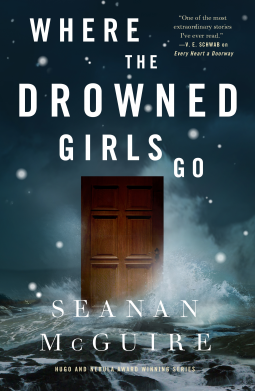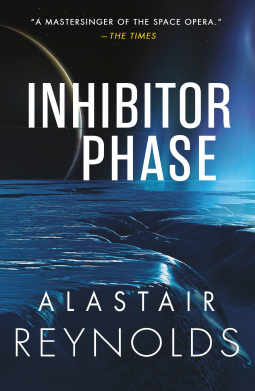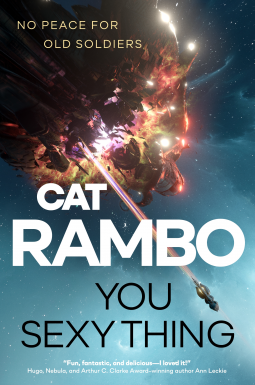Deborah J. Ross's Blog, page 25
October 7, 2022
Short Book Reviews: A Sweet M/M Historical Romance
 Resurrection Men, by Steven Harper (Darwin Press)
Resurrection Men, by Steven Harper (Darwin Press) Life in the late 1800s wasn’t easy for medical students from poor backgrounds like Arthur, and one of the few ways to pay tuition was through the illegal “resurrection” of buried corpses for use in anatomy laboratories. Life wasn’t much easier for Jesse, who fled his ultra-controlling, wealthy socialite family and ended up as a grave-digger. Now a vengeful judge is looking for a reason to throw Arthur in jail, and Arthur’s budding romance with Jesse might provide just the excuse.
The pacing of this historical novel is perfectly balanced, from desperate action to the sweet, slowing unfolding of a deep connection between the two men. Historical details create a vivid setting that heightens the stakes, drawing the reader ever deeper into this compelling story.
October 3, 2022
Let's Build a World: New Astronomical Finds for Your SF Stories
I've got a file (actually a dozen files) of cool science stories that I might use in science fictional world-building. What sf author doesn't? Even fantasy stories need good science. For instance, an urban fantasy involving werewolves really should depict the phases of the moon accurately. This week, images and data from the Hubble and James Webb Space Telescopes have furnished a treasure trove of research ideas. Rather than post them separately, I've gathered a few that I find particularly exciting.

There Could be Many Water Worlds in the Milky WayAstronomers are curious about how many terrestrial planets in our galaxy are actually “water worlds.”
These are rocky planets that are larger than Earth but have a lower density, which suggests that volatiles like water make up a significant amount (up to half) of their mass-fraction. According to a recent study by researchers from the University of Chicago and the Instituto de Astrofísica de Canarias (IAC), water worlds may be just as common as “Earth-like” rocky planets. These findings bolster the case for exoplanets that are similar to icy moons in the Solar System (like Europa) and could have significant implications for future exoplanet studies and the search for life in our Universe.
“We have discovered the first experimental proof that there is a population of water worlds, and that they are in fact almost as abundant as Earth-like planets. We found that it is the density of a planet and not its radius, as was previously thought, which separates dry planets from wet ones. The Earth is a dry planet, even though its surface is mostly covered in water, which gives it a very wet appearance. The water on Earth is only 0.02% of its total mass, while in these water worlds it is 50% of the mass of the planet.”
However, planets around M-type stars typically orbit so closely that they are tidally locked, where one side is constantly facing toward its sun. At this distance, any water on the planet’s surface would likely exist in a supercritical gas phase, increasing their sizes. As a result, Luque and Pallé theorized that in this population, water is bound to the rock or in closed volumes below the surface, not in the form of oceans, lakes, and rivers on the surface. These conditions are similar to what scientists have observed with icy moons in the outer Solar System, such as Jupiter’s moon Europa and Saturn’s moon Titan.
Given that they are tidally locked to their suns, these planets may also have liquid oceans on their sun-facing side but frozen surfaces everywhere else – colloquially known as “eyeball planets.” While astronomers have speculated about the existence of this class of exoplanet, these findings constitute the first confirmation for this new type of exoplanet. They also bolster the growing case for water worlds that form beyond the so-called “snow line” in star systems (the boundary beyond which volatile elements freeze solid), then migrate closer to their star.
 In the past, glaciers may have existed on the surface of Mars, providing meltwater during the summer to create the features we see today. Credit: NASA/JPL-Caltech/ESA
In the past, glaciers may have existed on the surface of Mars, providing meltwater during the summer to create the features we see today. Credit: NASA/JPL-Caltech/ESAMars Had Moving Glaciers, but They Behaved Differently in the Planet's Lower GravityOn Earth, shifts in our climate have caused glaciers to advance and recede throughout our geological history (known as glacial and inter-glacial periods). The movement of these glaciers has carved features on the surface, including U-shaped valleys, hanging valleys, and fjords. These features are missing on Mars, leading scientists to conclude that any glaciers on its surface in the distant past were stationary. However, new research by a team of U.S. and French planetary scientists suggests that Martian glaciers did move more slowly than those on Earth.These findings demonstrate how glacial ice on Mars would drain meltwater much more efficiently than glaciers on Earth. This would largely prevent lubrication at the base of the ice sheets, which would lead to faster sliding rates and enhanced glacial-driven erosion. In short, their study demonstrated that lineated landforms on Earth associated with glacial activity would not have had time to develop on Mars.
In addition to explaining why Mars lacks certain glacial features, the work also has implications for the possibility of life on Mars and whether that life could survive the transition to a global cryosphere we see today. According to the authors, an ice sheet could provide a steady water supply, protection, and stability to any subglacial bodies of water where life could have emerged. They would also protect against solar and cosmic radiation (in the absence of a magnetic field) and insulation against extreme variations in temperature.
If Jupiter's Orbit got Weirder, it Would Actually Make Earth More HabitableEarth is not just habitable, it’s unusually habitable. It’s rather wet for a planet so close to its Sun, it’s geologically active, and it has a stable orbit, all of which are necessary for life as we know it. But there are also secondary advantages, such as not being constantly bombarded by large asteroids, and having a rotational axis that is fairly stable. This is due in part thanks to the planet Jupiter. The giant planet has helped clear the solar system of asteroid debris and may have helped stabilize the orbits of the inner planets. So life is good. But a new study shows that if Jupiter had a different orbit, life could be even better.
The study looked at the way Jupiter affects Earth’s orbit and axial tilt over time. In this recent study, the team created simulated solar systems where Jupiter’s orbit had a higher eccentricity. They thought a more eccentric Jupiter would make Earth less habitable, but they were surprised to find it actually made things better. With an increased gravitational effect from Jupiter, the Earth would have better insolation over its surface, so that even more of Earth’s land masses would be within a temperate range.
This has big implications for potentially habitable worlds in other star systems. Although we tend to focus on whether a world is within the habitable zone, that’s only the first requirement for a truly habitable world. Other factors such as insolation depend on the presence of other planets in the system. There’s a gravitational dance between worlds that can make or break a planet’s chances for life.
[image error]
Webb Scans a Nearby Brown Dwarf and Finds it has Clouds Made of SandUsing data from the ERS, an international team of astronomers and astrophysicists conducted a direct imaging study of a brown dwarf companion (VHS 1256-1257 b) orbiting within a triple brown dwarf system approximately 69.0 light-years away. The spectra they obtained from this body provided a detailed composition of its atmosphere, which included an unexpected find – clouds made of silicate minerals (aka. sand)!
“The near-infrared and mid-infrared show features of methane, carbon monoxide, sodium, potassium, and water. There is evidence of carbon dioxide. All of these features have been observed before in brown dwarfs of this temperature. We have never seen carbon monoxide in such detail at 5 microns, though. These give us the opportunity in future studies to understand how much carbon and oxygen are in the overall object, which gives a clue to how “metal-rich” it is compared to its host star. The composition of a brown dwarf can potentially give insight into ways the object may have formed.”
Miles and her colleagues also noted the direct detection of silicate clouds, making this the first instance where such a phenomenon was made for a planetary-mass companion. This and other recent spectroscopic examinations of brown dwarfs (such as a recent study based on Spitzer data) confirm that these sub-stellar mass objects produce enough heat to vaporize minerals. It also provides insight into how planetary atmospheres work, particularly for planets that are closer in size and temperature to Earth.

Enceladus is Even More Habitable Than We ThoughtSo while hanging out with Goldilocks is a nice bonus for habitable worlds, it isn’t necessary. You just need a thermal energy source that can keep your water wet. And since water is more abundant in the outer solar system, it’s quite possible that life is far more common on the moons of gas giants than it is on Earth-like worlds. But water isn’t enough for life to survive. You need plenty of the common elements like carbon and nitrogen, which most rocky worlds should have, and you need some less common elements, in particular phosphorus.
Phosphorus is the 11th most abundant element on Earth, but it is the 6th most abundant element in our bodies. And it is absolutely vital for our survival. Phosphorus plays a major role in the structure of DNA and RNA and is a part of Adenosine triphosphate (ATP), which lets cells transfer energy, muscles contract, and nerve impulses travel around our brains. Every known living thing requires phosphorus to survive. So if we’re looking for extraterrestrial life, their worlds need not just water and heat, they also need phosphorus. And a new study has found such a world right in our backyard.
When the Cassini spacecraft was orbiting Saturn, it captured lots of data on several of its moons, including observations of water plumes coming from Enceladus. These plumes contained plenty of organic compounds, though phosphorus wasn’t detected. But a team studying Enceladus thought phosphorus was likely there. So they created a geochemical model including thermodynamic and kinetic behavior, and match their model to the Cassini observations. They found that the deep oceans of Enceladus likely extract phosphorus from the rocky ocean floor. This means that the seas of Enceladus are likely rich in phosphorus. Combined with the organic materials we know exist on the icy moon, there is plenty of chemistry to support life similar to Earth’s deep oceans.
September 30, 2022
Short Book Reviews: The Wrong School
Where the Drowned Girls Go, by Seanan McGuire (Tordotcom)

Every Heart a Doorway introduced a delighted readership to Eleanor West's Home for Wayward Children, a school for children who fall through doors to imaginary worlds and then fall back out again. Such children often cannot adapt to the normal world again, they are so changed—for good or ill—by their time in other worlds. Many are tormented by nightmares or dreams of longing. The Home for Wayward Children offers them a place of understanding where they can slowly reconcile with what has happened to them and what they have lost.
But it cannot help all of them.
Cora is one such child. She’s spent too much time as a mermaid, a hero, to be able to accept a world in which her physical body makes her a target for unending teasing. When she hears about The Whitethorn School, she jumps at the chance to transfer. From the moment she enters the new premises, she realizes how different this new school is. The barred windows. The terrified, pathologically obedient students. The autocratic matrons. The Stepford teachers. The sinister headmaster. She finds herself a prisoner, subjected to daily brainwashing, with no hope of escape.
Until one of her friends from the Home for Wayward Children comes to rescue her and becomes the Whitethorn’s latest victim.
Like its predecessors, Where the Drowned Girls Go is filled with glorious inventions, friendships, compassion, and page-turning action.
September 26, 2022
L'Shanah Tovah
September 23, 2022
Short Book Reviews: Tending a Sleeping Star

The Unbalancing, by R.B. Lemberg (Tachyon)
R. B. Lemberg’s The Unbalancing is an exquisite marriage of imaginative world-building, insightful relationships, and compelling story. Here stars are sentient, ghosts speak to their descendants, both sexuality and gender are accepted as fluid, and people work magic through their “deepnames.” It’s also a sweet love story between a reclusive poet and the brash new starkeeper who’s tasked with the care of a restless, unhappy, submerged star.
The story is rich in unexpected yet consistent details. Through the dual viewpoints, Lemberg guides the reader through the complexities of a world that is just like enough to our own to feel familiar and yet challenging at every turn. Its differences invite us to re-examine our assumptions about people, their nature, and their relationships. What would it be like if every person figured out for themselves if they belonged to a single gender, and if so which one, a combination, or an entirely new one? How does this affect political power? How is physical intimacy negotiated? Lemberg’s characters exemplify consent (“Is this good?” “Do you want me to go on?” “What would you like?”) as a normal, natural part of courtship, one the modern human world could emulate.
As with Lemberg’s previous novella, The Four Profound Weaves, The Unbalancing is a tale of emotional power and superbly handled prose that often approaches poetry in its nuance and poise. Highly recommended, with the suggestion that it be read slowly and savored.
September 19, 2022
Multivitamins and the Mind of Older Folks
I was a participant in the COSMOS trial (it was fun!) examining possible benefits for older folks from cocoa flavonoids and an ordinary multivitamin (they used Centrum Silver). While the cocoa extract had no effect on cognition, the multivitamin did--it actually improved cognition! (Cardiovascular events and cancer results are reported elsewhere). Here's the summary:
Vitamins, minerals, and other bioactives in foods are important for normal brain function, and deficiencies in older adults may increase risk for cognitive decline. Dietary supplements are often recommended for cognitive protection, but supporting evidence is mixed. COSMOS investigators partnered with colleagues at Wake Forest University to test whether daily use of cocoa extract or a multivitamin for 3 years can reduce the risk of cognitive decline. The COSMOS-Mind sub-study enrolled 2,262 COSMOS participants aged 65 and older who completed annual telephone interviews to assess memory and thinking abilities. The investigators found that cocoa extract did not affect cognition. On the other hand, daily multivitamin use improved cognitive function. That is, participants assigned to the multivitamin group had higher cognitive test scores after 3 years than the participants assigned to the multivitamin-placebo group. The investigators estimated that taking the daily multivitamin slowed cognitive aging by approximately 60%, or the equivalent of 1.8 years over the 3 years of the study, but this finding requires confirmation in future research. “COSMOS-Mind provides the first evidence from a large randomized trial to show that regular use of a typical daily multivitamin may improve memory and thinking abilities in older adults,” noted COSMOS Co-Director Dr. Howard Sesso, who leads COSMOS with Dr. JoAnn Manson. However, the story continues to unfold as other investigators complete separate studies in COSMOS that dig more deeply into the effects of both cocoa extract and a multivitamin on different aspects of cognition and other aging-related outcomes.
The whole study is here.
September 9, 2022
Short Book Reviews: Alastair Reynolds A Master of Space Opera
Inhibitor Phase, by Alastair Reynolds (Orbit)

I’m an unabashed fan of Alastair Reynolds’s science fiction. I love how he combines fascinating hard-science worldbuilding, pitch-perfect control of pacing, and characters who hold my interest even when, let’s face it, they’re downright weird. Inhibitor Phase is no exception. Not only that, but it’s readily accessible to readers who aren’t familiar with the previous books set in the Revelation Space universe.
The background is this: The Inhibitors, a ruthless, infinitely patient cybernetic entity, have all but wiped out humankind. Remnants survive by staying hidden and very, very quiet.
When a lone human ship blunders into the Michaelmas system, it’s only a matter of time before the Inhibitors take notice. For thirty years a tiny band of humans has been sheltering in the caverns of an airless, crater-pocked world. Their leader, Miguel de Ruyter, takes one of their few spacecraft to intercept the intruder ship and prevent this catastrophe. Floating in space, he encounters a refugee from the ship—an enigmatic woman who calls herself Glass—and embarks upon a near-suicidal, against-all-odds quest for a weapon against the Inhibitors.
Reynolds writes very, very good space opera, and this book is no exception. It’s longer than some of his other work, with more sprawling action and a ton of inventive details. Many of the entities de Ruyter (not his real name: hint!) encounters are weird, unpredictable, and deliciously alien.
September 5, 2022
What's New With Voyager 1?
Voyager 1 is no Longer Sending Home Garbled Data!
 This aging and still-valuable spacecraft has been exploring the outer parts of the solar system since its launch in 1977, along with its twin sibling, Voyager 2. They each traveled slightly different trajectories. Both went past Jupiter and Saturn, but Voyager 2 continued on to Uranus and Neptune. They’re both now outside the solar system, sending back data about the regions of space they’re exploring.
This aging and still-valuable spacecraft has been exploring the outer parts of the solar system since its launch in 1977, along with its twin sibling, Voyager 2. They each traveled slightly different trajectories. Both went past Jupiter and Saturn, but Voyager 2 continued on to Uranus and Neptune. They’re both now outside the solar system, sending back data about the regions of space they’re exploring.Voyager 1 flew past Jupiter in March 1979, and Saturn in November 1980. After its close approaches to those two gas giants, it started a trajectory out of the solar system and entered interstellar space in 2013. That’s when it ceased to detect the solar wind and scientists began to see an increase in particles consistent with those in interstellar space.
These days, Voyager 1 is more than 157.3 astronomical units from Earth and moving out at well over 61,000 km/hour. It’s busy collecting data about the interstellar medium and radiation from distant objects. If all goes well, the spacecraft should continue sending back data for nearly a decade. After that, it should fall silent as it travels beyond the Oort Cloud and out to the stars.
Earlier this year, however, the teams attached to the Voyager 1 mission noticed that the spacecraft was sending weird readouts about its attitude articulation and control system (called AACS, for short). Essentially, the AACS was sending telemetry data all right, but it was routing it to the wrong computer, one that had failed years ago. This corrupted the data, which led to the strangely garbled messages the ground-based crew received.
Once the engineers figured out that the old, dead computer might have been part of the problem, they had a way forward. They simply told the AACS to switch over sending to the correct computer system. The good news was that it didn’t affect science data-gathering and transmission. The best news came this week: team engineers have fixed the issue with the AACS and the data are flowing normally again.
The ongoing issue with AACS didn’t set off any fault protection systems onboard the spacecraft. If it had, Voyager 1 would have gone into “safe mode” while engineers tried to figure out what happened. During the period of garbled signals, AACS continued working, which indicated that the problem was either upstream or downstream of the unit. The fact that data were garbled provided a good clue to related computer issues.
This adapted article appeared in Universe Today. Click through for the full thing.
September 2, 2022
Short Book Reviews: A YA Regency Comedy, With Dragons

Scales and Sensibility (Regency Dragons Book 1), by Stephanie Burgis (Five Fathoms Press)
About 15 years ago, Jane Austen mashups were the hot new thing. Pride and Prejudice and Zombies by Seth Grahame-Smith came out in 2009, followed by a glut of similar parodies and even a film or two. The fad didn’t last, especially as the stories got more derivative and less creative. Stephanie Burgis’s Scales and Sensibility opens with an homage to Austen: “It is a truth universally acknowledged…” Other than an occasional textual reference to Austen’s prose, it has nothing in common with the earlier, vapid parodies. Instead, it takes off in its own whimsical and engaging direction. The protagonist is named Elinor, like the heroine of Austen’s Sense and Sensibility and she is indeed sensible, but there the resemblance ends. She is an orphaned cousin, not the eldest daughter, and her counterpart is not her romantic, good-hearted sister but her wealthy, narcissistic cousin, Penelope. When witnessing Penelope’s abuse of her fashionable miniature dragon becomes intolerable, Elinor kidnaps the tiny creature and runs away. Little does she know the dragon’s secret or guess the adventures the two will embark upon.
This novel rests comfortably in the intersection between Young Adult fantasy, Regency romance, and romantic comedy. It’s an engaging, quick read with enough schemes and mistaken identities to satisfy the reader.
August 26, 2022
Short Book Reviews: Cat Rambo's You Sexy Thing Cooks up a Madcap Adventure

You Sexy Thing, by Cat Rambo (Tor)
An assortment of ex-soldiers, human and alien, have recently retired from the a mind-linked military ad are about to realize their dreams: their restaurant is about to be reviewed by the foremost restaurant critic of the galaxy and possibly receive a coveted award. Wealthy patrons will then flock to their establishment, and riches will flow their way. What could possibly go wrong? To begin with, a package containing a possible imperial heir, an explosive assault on the space station in which they live and work, and being kidnapped by a sentient bioship, You Sexy Thing, which is programmed to take them to a prison planet before it’s hijacked by the most notorious, vicious, scheming pirate king of all time. So of course, the way out of their dilemma is to teach the ship to cook…
Cat Rambo’s space opera is at times hilarious, emotionally deep, complex, and playful, but always vastly entertaining. The worldbuilding details drew me along as the plot darkened and the characters revealed layer upon intricate layer of depth. I’m a sucker for stories that hook me with humor and whimsy before socking me in the gut. You Sexy Thing delivers on all counts. I’m particularly pleased to see that Rambo left the door open to a sequel, although with storytelling skill like this, I’ll gladly follow her into whatever new universe her imagination concocts.
https://netgalley-covers.s3.amazonaws.com/cover219574-medium.png





